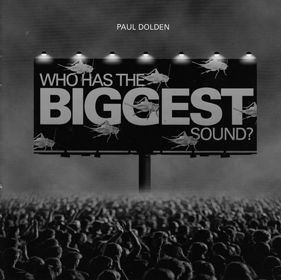Compact disc, 2014, Starkland ST-220; available from Starkland, P. O. Box 2190, Boulder, Colorado 80306, USA; telephone: (303) 449-6510; electronic mail info@starkland.com; http://www.starkland.com/.
Reviewed by Allan J. Cronin
Alameda, California, USA
 Paul Dolden is a Canadian musician whose work Immersion previously appeared on the Starkland label in a groundbreaking surround audio Dolby 5.1 compact disc released in 1997. His work also appeared on (the now out of print) A Storm of Drones (Asphodel ASP 0966) which was released in 1995. Dolden has also released four albums on the empreintes DIGITALes label. Like most non-pop Canadian musicians his work is little known in the United States. And the fact that this is his first album release in nine years has contributed to the lack of name recognition.
Paul Dolden is a Canadian musician whose work Immersion previously appeared on the Starkland label in a groundbreaking surround audio Dolby 5.1 compact disc released in 1997. His work also appeared on (the now out of print) A Storm of Drones (Asphodel ASP 0966) which was released in 1995. Dolden has also released four albums on the empreintes DIGITALes label. Like most non-pop Canadian musicians his work is little known in the United States. And the fact that this is his first album release in nine years has contributed to the lack of name recognition.
Dolden is a multi-instrumentalist born in Ottowa, Ontario, Canada in 1956. He plays violin, cello, and electric guitar but it is his recording techniques that distinguish him most prominently. Reviewers have described his work variously as “post-modern”, “electroacoustic” and “ambient”. However, these general categories yield few clues as to the actual sound and impact of his work. One is hard pressed to definitively categorize his work into a single genre.
Dolden works with acoustic instruments, alternate tunings, and digital editing techniques. His influences include rock, jazz, and classical music. He produces recordings that are both densely complex and lucid. Far from being a tinkerer with laptop digital editing software, he has succeeded in establishing a unique and interesting compositional voice through rigorous and learned use of composition methods and studio editing.
His 1994 album L'Ivresse del la Vitesse (empreints DIGITALes IMED 9417/9418) earned a listing in Wire Magazine's “100 Records That Set the World on Fire.” This was Dolden's last solo release before the present album. Three previous albums were collections of shorter works, the 1990 release, Threshold of Deafening Silence (Tronia TRD 0190) with works from 1984-1989, Seuil de silences from 2003 (empreintes DIGITALes IMED 0369) containing works from 1986-1996 and Délires de Plaisirs (empreintes DIGITALes IMED 0577) containing works composed between 1995-2002.
The present compact disc contains two works, the main attraction being Who Has the Biggest Sound? written between 2005 and 2008, and the 2010 work The Un-Tempered Orchestra. Each work contains several sections, spread over separate tracks.
The first work might be described as a sort of electronic oratorio in 15 sections. It is an occasionally humorous meditation on sound that has a complexity dense with quotation and reference that might remind one of Luciano Berio's Sinfonia. At times, one hears the channel changing quasi-improvisatory sound associated with Carl Stalling and later John Zorn. Rock, jazz, and classical elements compete in a dense texture as the dream-like composition unfolds. I am struck by a variety of comparisons including Robert Ashley’s operas, John Cage’s collage pieces like Roaratorio, Alvin Curran’s Animal Behavior, and the live electronic performances of Salvatore Martirano. It is a work whose genesis required hundreds of studio hours and, though it doesn't yield its charms easily, it rewards repeated listening.
The Un-Tempered Orchestra is cast in six sections. This is a very different approach from the previous work though the composer's style is easily recognizable. The liner notes make reference to Harry Partch and this is certainly apt, but this writer heard influences from the likes of Lou Harrison, James Tenney, and La Monte Young.
The six sections of this work lack the enigmatic poetic titles of the first work and it has a more intimate, almost chamber music ambience to it by contrast. The work is in part an homage to J. S. Bach and The Well Tempered Clavier, in that it explores the endless possibilities of alternate tunings in a methodical deconstruction of the system that has dominated Western music for the last 250 years. But don’t be fooled, this piece is not a didactic academic exercise. Rather it is an entertaining piece of music.
Overall, this album is very competently composed, produced, and mixed by Dolden. He certainly meets the high quality sound standards that listeners have come to expect from the Starkland label. And apart from a review of Dolden's previous album, the composer writes all the liner notes. Executive producer Tom Steeland, who once again casts his wide ranging net to capture some very unusual and interesting music, also created the appropriately enigmatic cover art.